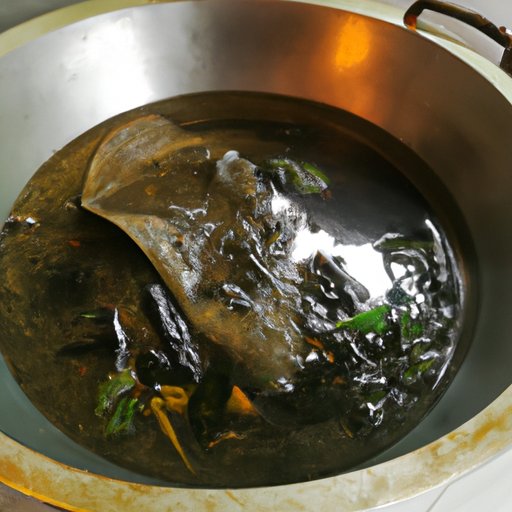Introduction
A sitz bath is a shallow bath used for cleansing and healing the perineal area. It is a popular home remedy for treating various conditions such as hemorrhoids, anal fissures, vaginal infections, and postpartum discomfort. It is also used to promote general relaxation and well-being.

Definition of a Sitz Bath
The term “sitz bath” comes from the German word “sitzbad”, which literally translates to “sitting bath”. A sitz bath is a shallow bath taken while sitting in a tub filled with warm or cool water. The water should be deep enough to cover the hips and buttocks, but not so deep that it covers the chest or neck. Sitz baths can be done with or without the addition of herbs, essential oils, or other substances.

Overview of Benefits of a Sitz Bath
Sitz baths are a safe and natural way to treat a variety of ailments, including:
- Hemorrhoids
- Anal fissures
- Vaginal infections
- Postpartum discomfort
- Painful urination
- Perineal tears
- General relaxation and well-being
The warm water helps to relax muscles and improve circulation, which can reduce pain and inflammation. Additionally, the added herbs, essential oils, or other substances can provide additional healing benefits.
Types of Sitz Baths
There are several different types of sitz baths that can be used to treat different ailments. Here are some of the most common types:
Hot/Warm Sitz Baths
Hot or warm sitz baths are commonly used to treat hemorrhoids, anal fissures, and postpartum discomfort. The warm water helps to relax muscles and improve circulation, which can reduce pain and inflammation. The temperature of the water should be comfortable, but not too hot. If the water is too hot, it could cause further irritation.
Cold Sitz Baths
Cold sitz baths are commonly used to treat painful urination, perineal tears, and vaginal infections. Cold water can help reduce inflammation and relieve itching and burning. Cold sitz baths should be done for no longer than 15 minutes at a time.
Herbal Sitz Baths
Herbal sitz baths are baths made with herbs or essential oils. Herbs such as chamomile, lavender, and calendula have anti-inflammatory and antiseptic properties that can help reduce swelling and pain. Essential oils like tea tree oil and eucalyptus oil can also help reduce inflammation and relieve itching and burning. When adding herbs or essential oils to a sitz bath, it is important to use only a few drops to avoid skin irritation.
Steps to Take When Doing a Sitz Bath
When doing a sitz bath, there are several steps to take to ensure safety and effectiveness. Here are the steps to follow:
Preparing the Sitz Bath
Before getting into the tub, it is important to make sure everything is properly prepared. Fill the tub with the desired temperature of water (hot, warm, or cold). If using herbs or essential oils, add a few drops to the water. Make sure the room is comfortable and the lighting is dim. Place a towel, pillow, or cushion on the edge of the tub for comfort.
Sitting in the Tub
Once the tub is prepared, sit in the water and let your body adjust to the temperature. Make sure the water is covering your hips and buttocks. Relax and focus on your breathing. Stay in the tub for 10-15 minutes, or until the water starts to cool. When finished, slowly stand up and dry off with a clean towel.
Cleaning Up After the Sitz Bath
After the sitz bath, it is important to dispose of the water safely. Do not pour the water down the drain, as it may contain bacteria or other contaminants. Instead, place the water in a bucket or container and dispose of it outside. Rinse the tub with clean water and wipe it down with a clean cloth. Allow the tub to air dry before putting it away.

Science Behind a Sitz Bath
So how does a sitz bath actually work? The warm or cold water helps to relax muscles and improve circulation, which can reduce pain and inflammation. The added herbs or essential oils provide additional healing benefits. For example, chamomile has anti-inflammatory and antiseptic properties that can help reduce swelling and pain, while tea tree oil can help reduce inflammation and relieve itching and burning.
History of Sitz Baths
Sitz baths have been around for centuries and were originally used by ancient civilizations for medical and spiritual reasons. In the 19th century, sitz baths became more popular in Europe as a way to treat various ailments. Today, sitz baths are still a popular home remedy for treating a variety of conditions.
Conclusion
A sitz bath is a simple, at-home remedy that can help reduce pain and inflammation in the pelvic area. There are several different types of sitz baths, including hot/warm, cold, and herbal baths. When doing a sitz bath, it is important to prepare the tub, sit in the water, and clean up after. The science behind a sitz bath shows that the warm or cold water helps to relax muscles and improve circulation, while the added herbs or essential oils provide additional healing benefits. Finally, sitz baths have a long history and have been used by many cultures throughout the centuries.
(Note: Is this article not meeting your expectations? Do you have knowledge or insights to share? Unlock new opportunities and expand your reach by joining our authors team. Click Registration to join us and share your expertise with our readers.)
